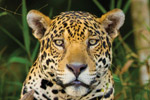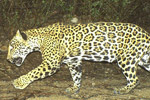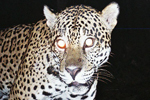Catching a jaguar on a remote camera trap in the Amazon is a rare, happy sight. But catching a jaguar attempting to ambush a herd of peccaries is quite simply astonishing.
“A research assistant, who was coding the videos sent me an email to have a look,” said primatologist, Mark Bowler, a postdoctoral fellow at the Institute for Conservation Research at San Diego Zoo Global. “I saw the herd of peccaries run, and agreed that it was nice, but as they left the frame was thinking it couldn’t possibly have the predator in it. It was one of those jaw-on-the-floor moments!”
Bowler is using camera traps in the Amazonian canopy to video arboreal mammals, especially monkeys, but he’s also studying land mammals of Peru’s Maijuna-Kichwa Regional Conservation Area. It’s here that the jaguar hunt was captured.
“We are looking at the recovery of animal populations after the local indigenous people, known as the Maijuna kicked out all loggers and thus stopped chronic overhunting,” Bowler told mongabay.com.
Describing the recovery as “remarkable,” Bowler says he suspects that the return of vast herds of white-lipped peccaries (Tayassu pecari) has allowed big cats, like jaguars (Panthera onca), to also stage a comeback in the region.
White-lipped peccaries are known in the Amazon as ecosystem engineers, especially as they often travel in herds of several hundred, tearing up the ground looking for nuts and fruits.
“The white-lipped peccaries are also tremendously important as prey for indigenous hunters and jaguars alike,” said Bowler.
Around 400 Maijuna people live in four village in the region, along the Napo and Putumayo Rivers. In 2012, they established the 391,000 hectare Maijuna-Kichwa Regional Conservation Area to safeguard their forests and the biodiversity within.
“The Maijuna are conscious of what can happen when there is overhunting, they had not seen peccary herds in their lands for a decade when they stopped the loggers,” noted Bowler. “They are keen to manage hunting, principally by keeping outsiders from hunting in their territories, to make sure the herds remain in the area. If they can achieve this, it can only be good for jaguars too.”
But this nascent protected area—and the Maijuna people themselves—are now threatened by government plans to build a road through their territory, according to Bowler. The indigenous people fear that the road could bring a new wave of colonizers into the forest, devastating white-lipped peccary and jaguar populations once again.
Related articles
|
What makes the jaguar the ultimate survivor? New books highlights mega-predator’s remarkable past and precarious future (10/02/2014) For thousands of years the jaguar was a God, then it was vermin to be destroyed, and today it is the inspiration for arguably the most ambitious conservation effort on the planet. A new book by renowned big cat conservationist, Alan Rabinowitz, tells this remarkable story from the jaguar’s evolutionary origins in Asia to its re-emergence today as a cultural and ecological symbol. |
|
Seeking justice for Corazón: jaguar killings test the conservation movement in Mexico (07/31/2014) Eight years ago, a female jaguar cub was caught on film by a motion-triggered camera trap set in the foothills of canyons, oak forest, and scrubland that make-up the Northern Jaguar Reserve, just 125 miles south of the U.S.-Mexico border. Three years later, in 2009, the jaguar reappeared on film as an adult. They called her ‘Corazón’ for the distinctive heart-shaped spot on her left shoulder. |
|
Four donors pledge $80 million for big cats (06/03/2014) Four donors from around the world have pledged $80 million to cat conservation group, Panthera. The money will fund projects working to preserve tigers, lions, jaguars, cheetahs, leopards, snow leopards, and cougars over ten years. |
|
Jaguars in Argentine Chaco on verge of local extinction (12/23/2013) The majestic jaguar (Panthera onca), the largest of the New World cats, is found as far north as the southern states of the US, and as far south as northern Argentina. In the past jaguars ranged 1,500 kilometers (930 miles) further south, but their range has shrunk as habitat loss and human disturbance have increased. Overall, jaguars are classified as Near Threatened by the IUCN, but the level of risk facing jaguars varies by region. Populations in Argentina, at the present-day southern range limit, have previously been identified as some of the most threatened of them all. |
|
60 big cats killed in Brazilian parks in last two years (06/24/2013) At least 60 big cats have been killed within national protected areas in Brazil during the past two years according to a recent survey published in mongabay.com’s open access journal Tropical Conservation Science. The report, which focuses on jaguar (Panthera onca) and puma (Puma concolor) populations, within Brazilian protected areas shows that reserve management and use restrictions impact the level of big cat hunting. |
|
Crazy cat numbers: unusually high jaguar densities discovered in the Amazon rainforest (05/16/2013) Jaguars (Panthera onca) are the biggest cat in the Americas and the only member of the Panthera genus in the New World; an animal most people recognize, the jaguar is also the third largest cat in the world with an intoxicatingly dangerous beauty. The feline ranges from the harsh deserts of southern Arizona to the lush rainforests of Central America, and from the Pantanal wetlands all the way down to northern Argentina. These mega-predators stalk prey quietly through the grasses of Venezuelan savannas, prowl the Atlantic forests of eastern Brazil, hunt along the river of the Amazon, and even venture into lower parts of the Andes. |




